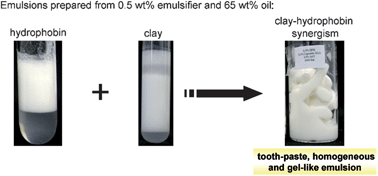Pickering emulsions stabilized by novel clay–hydrophobin synergism
Abstract
We have studied the physico-chemical properties of high internal oil in

* Corresponding authors
a
University of Bayreuth, BZKG/BayColl, Gottlieb-Keim-Straße 60, Bayreuth, Germany
E-mail:
Martin.Reger@uni-bayreuth.de
b
Shiseido Research Center, 2-2-1 Hayabuchi, Tsuzuki-ku, Yokohama, Japan
E-mail:
tomoko.sekine@to.shiseido.co.jp
We have studied the physico-chemical properties of high internal oil in

 Please wait while we load your content...
Something went wrong. Try again?
Please wait while we load your content...
Something went wrong. Try again?
M. Reger, T. Sekine, T. Okamoto, K. Watanabe and H. Hoffmann, Soft Matter, 2011, 7, 11021 DOI: 10.1039/C1SM06525D
To request permission to reproduce material from this article, please go to the Copyright Clearance Center request page.
If you are an author contributing to an RSC publication, you do not need to request permission provided correct acknowledgement is given.
If you are the author of this article, you do not need to request permission to reproduce figures and diagrams provided correct acknowledgement is given. If you want to reproduce the whole article in a third-party publication (excluding your thesis/dissertation for which permission is not required) please go to the Copyright Clearance Center request page.
Read more about how to correctly acknowledge RSC content.
 Fetching data from CrossRef.
Fetching data from CrossRef.
This may take some time to load.
Loading related content
